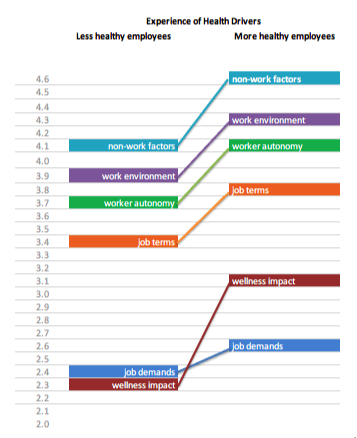Beyond Quick Fixes: The Hidden Culprits Eroding Employee Health
One of the most common challenges our clients face is burnout and workplace stress, leading to absenteeism, work conflict, employee turnover, and low morale that permeates workplace culture.
US workers are among the most stressed in the world. The details are frightening: 42% of employees report that yelling and other verbal abuse is common. No wonder that 83% of employees report work-related stress— stress that results in one million employees a day absent from work; 120,000 annual deaths and $190 billion in annual healthcare costs. These health-related costs total in the trillions of dollars for U.S. employers each year.
A burgeoning $11 billion corporate wellness industry has emerged to fill the need. Collaborating with well-intended employers, this rapidly growing health and wellness sector offers a wide collection of employer-sponsored programs: discounts to gyms, sessions on healthy eating and weight loss programs, meditation apps, time management workshops, and even incentives for health screenings.
While these initiatives seem valuable, there is limited or mixed evidence that wellness programs are alleviating the health-related problems they aim to solve, and increasing evidence that organization-level interventions are more effective than those directed at individuals.
So, What Drives Employee Health?
In our society, people tend to believe that our health is predominantly the result of our personal choices. But a large body of empirical evidence shows how the circumstances in which we make our choices significantly impact health outcomes.; the workplace itself is a significant risk factor for morbidity and mortality, including cardiovascular disease, diabetes, obesity, and behavioral health issues. A quote from a market analysis for the corporate wellness industry highlights this paradox: “The high prevalence of extended work hours, heavy workload, and work pressure related issues are creating physical and mental repercussions, such as hypertension, heart attacks, and a feeling of instability among the employees…employees work under a lot of pressure and excessive demands.” In other words: the workplace itself becomes the driving force behind the very health problems that wellness programs are trying to combat. In fact, the behaviors that wellness programs want to curb—such as smoking and drinking—can be triggered by workplace conditions.
Testing It Out
Our team decided to test out the link between workplace conditions and health. We built and piloted a simple survey in 2022 in the St. Louis Metropolitan Statistical Area (MSA), including employees in all pay ranges, and in a wide array of industries and job responsibilities.
Employees evaluated their health and wellness across four dimensions, and then indicated how they experience their workplace related to specific conditions at work. Strong evidence indicates that the following conditions impact health and wellbeing: an employee’s level of decision-making over their work; job demands such as hours and stress; the work environment, and job terms such as relative pay, benefits and job security. Because wellness programs are so prevalent, the survey also asked about wellness program offerings. Finally, it asked about conditions outside of work, in order to gauge how outside influences weigh against workplace influences on health and wellbeing.
We found that “more healthy” employees scored higher (better) on every workplace condition compared to “less healthy” employees. We also found that wellness programs were less accessible and effective for “less healthy” employees. Healthier employees were also more satisfied with their jobs.
Results demonstrating less healthy employees and associated health drivers compared to more healthy employees and associated health drivers.
If We Really Care About Employee Health…
Employers, who aren’t typically health experts, often rely on the wellness industry for solutions. So it’s no surprise that the wellness industry tends to emphasize the importance of healthy employee behaviors, rather than addressing the unique work environments of each employer. Selling wellness products geared at individuals is easier than counseling changes in workplace practices. This is a missed opportunity: employers have much more influence over workplace conditions than individual behaviors.
The good news is that the specific conditions within each workplace present opportunities for healthier workers. In a call center setting, employees may lack control over their tasks, with limited opportunities to utilize their skills and make decisions about their work. An intervention, described by the Work and Well-Being Initiative demonstrated the power of providing call center workers with more responsibility, such as managing work hours, breaks, team-building activities, and handling customer complaints with less managerial involvement. The results were remarkable: workers reported increased autonomy, job satisfaction, and supervisors observed improved performance. Even small and cost-effective changes can make a significant difference.
Making this shift isn’t easy, but employers who are brave enough to do it could unlock a range of promising practices in areas that decades of research have proven to impact health like “scheduling, management practices, staff resources, performance reviews, or job design.” Rather than throwing more money at wellness programs that aren't showing results, employers can focus on making changes in their workplaces that research proves can lead to better job satisfaction, greater retention and higher quality work.


